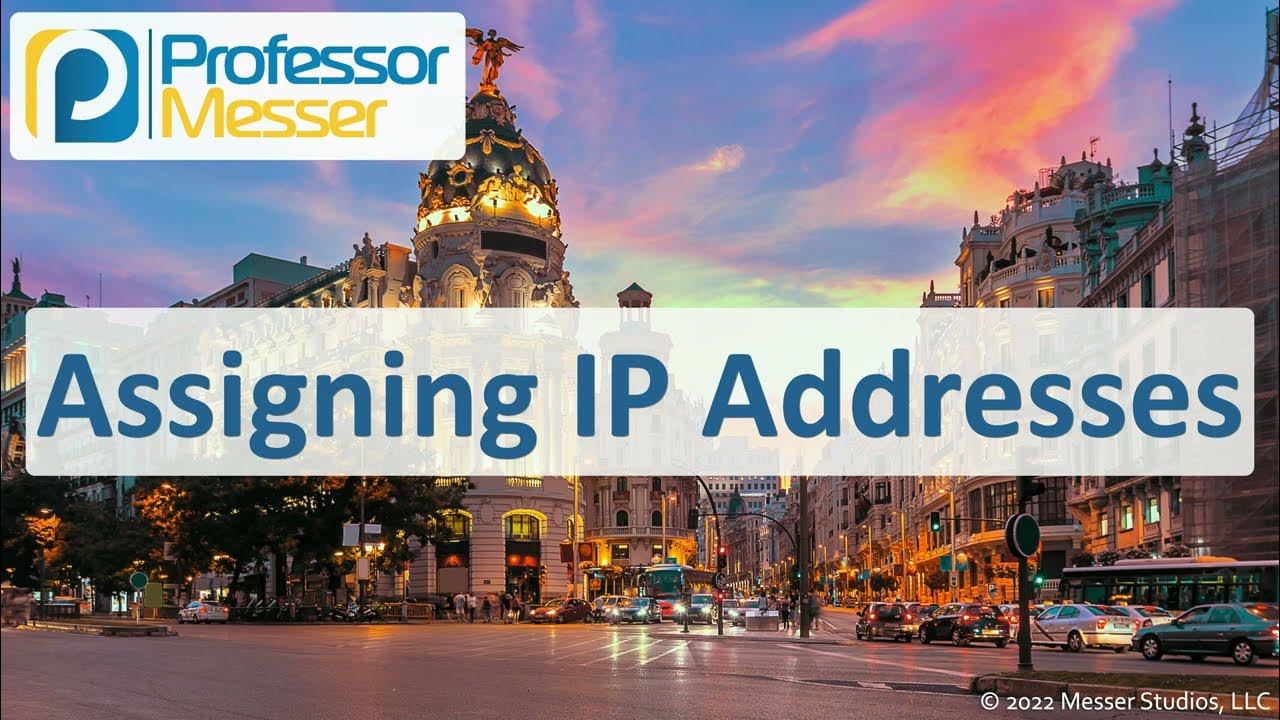Configuring DHCP - CompTIA Network+ N10-009 - 3.4
Summary
TLDRThis video delves into the configuration settings of DHCP servers. It explains how DHCP servers allocate IP addresses through a pool defined within a scope, including subnet masks, lease durations, and DNS configurations. The video also covers address reservations for devices like printers and servers, ensuring consistent IP allocation. Additionally, it explores the lease renewal process and DHCP options, which allow administrators to configure additional settings, such as VoIP call servers or HTTP proxies, alongside standard network settings like IP addresses and gateways.
Takeaways
- 📡 The DHCP server manages a pool of IP addresses, called a DHCP scope, which is used to assign addresses to devices on the network.
- 📝 The DHCP scope includes essential configurations like the IP address range, subnet mask, lease duration, and additional settings such as DNS servers and default gateways.
- ⚙️ Devices can have specific IP addresses reserved via MAC address mapping, ensuring they always receive the same address (static DHCP assignment).
- 📋 DHCP leases are temporary, and devices must renew their lease after a certain period or release the IP when they disconnect.
- ⏲️ DHCP servers use timers (T1 and T2) to renew IP leases—T1 timer starts renewal at 50% of the lease time, and T2 begins rebinding at 87.5%.
- 🔄 If the original DHCP server becomes unavailable, the device can attempt to renew the lease with any available DHCP server after the T2 timer.
- 🔧 DHCP also supports additional configuration options, known as DHCP options, allowing customization beyond IP addresses (e.g., Voice over IP server settings).
- 📑 There are 254 potential DHCP options, ranging from basic network settings to more specialized ones like HTTP proxies or call servers.
- 🖥️ Administrators can manage all these settings centrally through the DHCP server, reducing the need for manual configuration on individual devices.
- 📊 On Windows Server, administrators can view and modify the DHCP scope settings, including address pools, lease information, and reserved IPs via Server Manager.
Q & A
What is a DHCP scope and what does it typically include?
-A DHCP scope is a defined list or pool of IP addresses that a DHCP server uses to assign to devices on a network. It typically includes an IP address range to be handed out, addresses to be excluded from the pool, and the subnet mask.
What is a lease duration in DHCP and how does it affect IP addresses?
-A lease duration in DHCP is the time period for which an IP address is assigned to a device. After this period, the IP address is returned to the pool and can be assigned to another device if not renewed.
What are the additional options that can be configured in a DHCP scope?
-Additional options that can be configured in a DHCP scope include DNS servers, default gateways, and other optional settings such as Voice Over IP server IP addresses.
How does a DHCP server handle exceptions to the IP address pool?
-A DHCP server can handle exceptions by allowing administrators to add specific addresses to the scope that should be excluded from the pool or reserved for particular devices.
What is the purpose of creating a contiguous pool of IP addresses on a per-subnet basis?
-Creating a contiguous pool of IP addresses on a per-subnet basis allows the DHCP server to efficiently manage and distribute IP addresses to devices within that specific subnet.
What is a DHCP reservation and how does it differ from a regular DHCP assignment?
-A DHCP reservation is a feature that ensures specific devices always receive the same IP address each time they request it. This differs from a regular DHCP assignment where devices are dynamically assigned IP addresses from the pool.
How does the DHCP server recognize devices that have previously connected to the network?
-The DHCP server recognizes devices by keeping track of their MAC addresses and the IP addresses they have been assigned. If the device reconnects and the previously assigned IP address is available, it will be reassigned.
What is the process for manually configuring an IP address on a device like a printer or a server?
-Manually configuring an IP address on a device involves setting a static IP address directly on the device itself. This method does not scale well and requires manual updates if changes are needed.
What is the benefit of using address reservation in DHCP for devices like printers and servers?
-Using address reservation in DHCP ensures that critical devices like printers and servers always receive the same IP address, simplifying network management and avoiding IP conflicts.
How does the lease time for DHCP addresses work and who determines its length?
-The lease time is the duration for which an IP address is leased to a device and is determined by the DHCP administrator within the DHCP server settings. It can vary based on organizational needs.
What are the T1 and T2 timers in DHCP and how do they affect the lease renewal process?
-The T1 timer is set at 50% of the lease time, prompting the device to attempt to renew the lease with the original DHCP server. If the server is unavailable, the T2 timer at 87.5% of the lease time allows the device to renew the lease with any available DHCP server.
What are DHCP options and how are they configured?
-DHCP options are additional TCP/IP settings that can be configured through DHCP, such as call server IP addresses or HTTP proxy settings. They are configured by specifying the option number and its value within the DHCP server settings.
Outlines

此内容仅限付费用户访问。 请升级后访问。
立即升级Mindmap

此内容仅限付费用户访问。 请升级后访问。
立即升级Keywords

此内容仅限付费用户访问。 请升级后访问。
立即升级Highlights

此内容仅限付费用户访问。 请升级后访问。
立即升级Transcripts

此内容仅限付费用户访问。 请升级后访问。
立即升级5.0 / 5 (0 votes)






